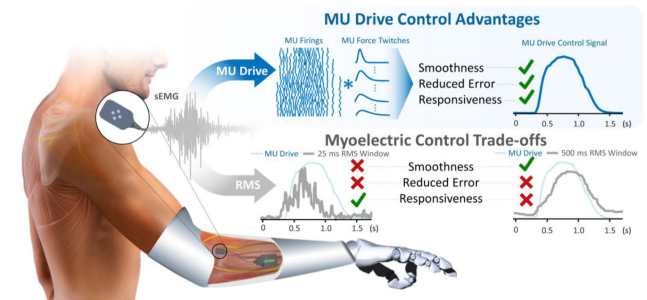Modern prosthetic limbs have made strident gains in recent years, incorporating terminal electromechanical devices that are capable of mimicking the human hand. However, access to these advanced control capabilities has been prevented by fundamental limitations of amplitude-based myoelectric neural interfaces, which have remained virtually unchanged for over four decades.
Consequently, nearly 23% of adults and 32% of children with major traumatic or congenital upper-limb loss abandon regular use of their myoelectric prosthesis. To address this healthcare need, the authors developed a non-invasive neural interface technology that maps natural motor unit increments of neural control and force into biomechanically informed signals for improved prosthetic control.

Therefore, the research group developed a new technology, referred to as motor unit drive (MU Drive), which utilizes real-time machine learning algorithms for directly measuring motor unit firings from surface electromyographic signals recorded from residual muscles of an amputated or congenitally missing limb using a wireless HDsEMG sensor.
The extracted firings are transformed into biomechanically informed signals based on the force-generating properties of individual motor units to provide a control source that represents the intended movement.
The team evaluated the characteristics of the MU Drive control signals and compared them to conventional amplitude-based myoelectric signals in healthy subjects as well as subjects with congenital or traumatic trans-radial limb-loss.
The analysis established a vital proof-of-concept: MU Drive provides a more responsive real-time signal with improved smoothness and more faithful replication of intended limb movement that overcomes the trade-off between performance and latency inherent to amplitude-based myoelectric methods.

As for the signifance of this work, MU Drive is the first neural interface for prosthetic control that provides non-invasive real-time access to the natural motor control mechanisms of the human nervous system.
This new neural interface holds promise for improving prosthetic function by achieving advanced control that better reflects the user intent. Beyond the immediate advantages in the field of prosthetics, MU Drive provides an innovative alternative for advancing the control of exoskeletons, assistive devices, and other robotic rehabilitation applications.
Reference: Twardowski MD, Roy SH, Li Z, Contessa P, De Luca G, Kline JC. Motor unit drive: a neural interface for real-time upper limb prosthetic control. J Neural Eng. 2019 Feb;16(1):016012. doi: 10.1088/1741-2552/aaeb0f. Epub 2018 Oct 24. PMID: 30524105; PMCID: PMC6349039.
